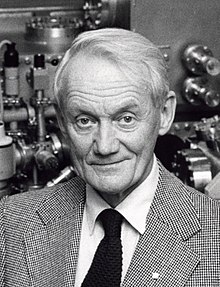|
Kai Siegbahn
Kai Manne Börje Siegbahn (20 April 1918 – 20 July 2007) was a Swedish physicist who shared the 1981 Nobel Prize in Physics.[1] BiographySiegbahn was born in Lund, Sweden, son of Manne Siegbahn the 1924 physics Nobel Prize winner. Siegbahn earned his doctorate at the University of Stockholm in 1944. He was professor at the Royal Institute of Technology 1951–1954, and then professor of experimental physics at Uppsala University 1954–1984, which was the same chair his father had held.[2] He shared the 1981 Nobel Prize in Physics with Nicolaas Bloembergen and Arthur Schawlow. Siegbahn received half the prize "for his contribution to the development of high-resolution electron spectroscopy" while Bloembergen and Schawlow received one quarter each "for their contribution to the development of laser spectroscopy".[3] Siegbahn referred to his technique as Electron Spectroscopy for Chemical Analysis (ESCA); it is now usually known as X-ray photoelectron spectroscopy (XPS). In 1967 he published a book, ESCA; atomic, molecular and solid state structure studied by means of electron spectroscopy.[4] He was a member of several academies and societies, including the Royal Swedish Academy of Sciences, and was president of the International Union of Pure and Applied Physics from 1981 to 1984.[5] Siegbahn married Anna Brita Rhedin in 1944. The couple had three sons (two physicists and a biochemist).[5][6] Siegbahn died on 20 July 2007 at the age of 89.[1] At the time of his death he was still active as a scientist at the Ångström Laboratory at Uppsala University.[6] AwardsAs well as a share of the 1981 Nobel Prize in Physics, Siegbahn won the following awards:[5]
References
External links
|
||||||||||||||||||||

